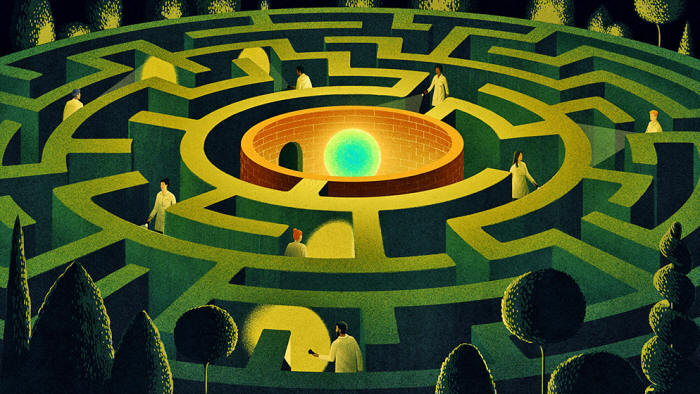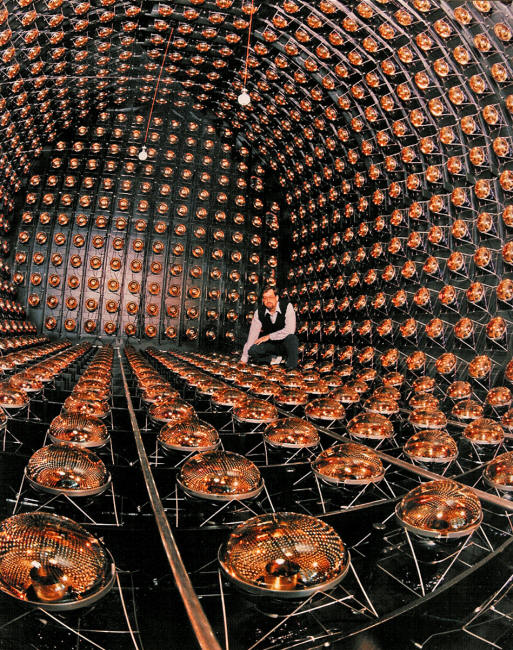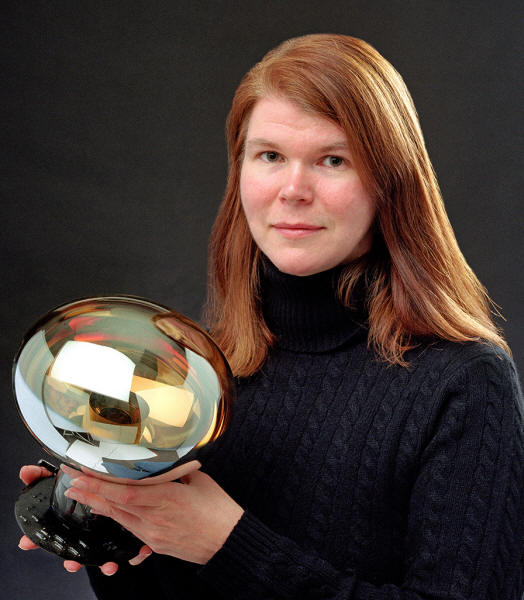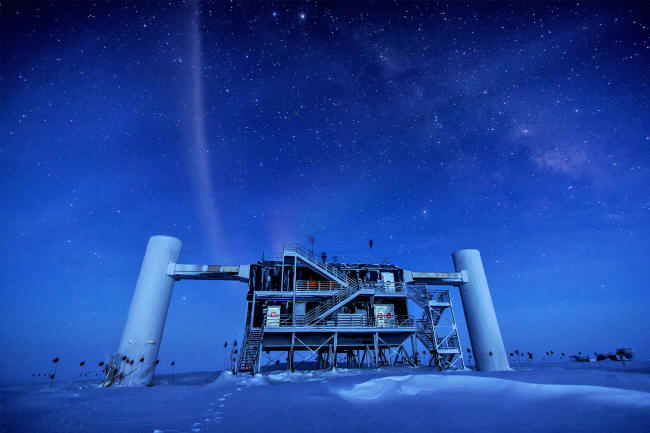|
feel they're navigating a labyrinth, unsure which threads to follow
and
which might be leading them astray. have led physicists to propose a "dark sector" of invisible particles - one that could simultaneously explain dark matter, the puzzling expansion of the universe, and other mysteries...
The problem was that they saw too many.
Theorists had postulated that neutrinos might oscillate between types as they fly along - a hypothesis that explained various astronomical observations.
LSND had set out to test this idea by aiming a beam of muon neutrinos, one of the three known types, toward the oil tank, and counting the number of electron neutrinos that arrived there.
Yet Louis and his team detected far more electron neutrinos arriving in the tank than the simple theory of neutrino oscillations predicted.
Since then, dozens more neutrino experiments have been built, each grander than the last. In mountains, disused mining caverns and the ice beneath the South Pole, physicists have erected cathedrals to these notoriously slippery particles.
But as these experiments probed neutrinos from every angle, they kept yielding conflicting pictures of how the particles behave.
In Jorge Luis Borges' 1941 short story of that title, time branches into an infinite number of possible futures.
With neutrinos, contradictory results have sent theorists down a variety of paths, unsure which data to trust and which might be leading them astray.
In 1993, the Liquid Scintillator Neutrino Detector at Los Alamos National Laboratory reported a puzzling bounty of neutrino detections. Rick Bolton, an engineer, is shown kneeling among the photomultiplier tubes that would detect light from neutrino interactions
inside the tank once it was filled with mineral oil.
The simplest explanation of the LSND anomaly was the existence of a new, fourth kind of neutrino, dubbed the sterile neutrino, that mixes up all the neutrino types according to new rules.
Sterile neutrinos would allow muon neutrinos to oscillate more readily into electron neutrinos over the short distance to the oil tank.
But as time went on, the sterile neutrino didn't fit the results of other experiments.
Forced to retrace their steps, physicists have been rethinking what's behind the muddle of hints and half results.
In recent years, they've devised new theories that are more complicated than the sterile neutrino, but which, if correct, would thoroughly revolutionize physics - resolving anomalies in neutrino oscillation data and other major mysteries of physics at the same time.
Not least, the new models posit heavy additional neutrinos that could account for dark matter, the invisible stuff enshrouding galaxies that seems to be four times more abundant than normal matter.
Now, four analyses released yesterday by the MicroBooNE experiment at the Fermi National Accelerator Laboratory near Chicago and another recent study from the IceCube detector at the South Pole both suggest that these more complex neutrino theories may be on the right track - though the future remains far from clear.
A Desperate Remedy
When Wolfgang Pauli postulated the existence of the neutrino in 1930 to explain where energy was disappearing to during radioactive decay, he called it a "desperate remedy."
His theoretical construct had no mass or electric charge, making him doubt an experiment could ever detect it.
But in 1956, in an experiment not unlike LSND, there the neutrino was.
Triumph soon veered into confusion when physicists detected neutrinos coming from the sun, a natural source of the particles, and found fewer than half the number predicted by theoretical models of stars' nuclear reactions.
By the 1990s, it was clear that neutrinos were behaving oddly.
Not only did solar neutrinos seem to mysteriously disappear, but so too did the neutrinos that fall to Earth when cosmic rays collide with the upper atmosphere.
One solution, proposed earlier by the Italian physicist Bruno Pontecorvo, was that neutrinos are shape-shifters...
Like many elementary particles, they come in three types:
So, rather than pulling a vanishing act, Pontecorvo suggested, neutrinos might transform between these species while they traveled.
Some of the electron neutrinos churned out by the sun, for example, could turn into muon neutrinos and so seem to disappear. In time, theorists homed in on a description of how neutrinos oscillate between types depending on their energy and travel distance that matched the data coming from the sun and sky.
But the idea of shape-shifting neutrinos was hard for many physicists to stomach.
The math only works if each of the three neutrino species is a quantum mechanical mix of three different masses - in other words, shape-shifting means neutrinos must have mass.
But the Standard Model of particle physics, the well-tested set of equations describing the known elementary particles and forces, unequivocally deems neutrinos massless.
The sun and atmosphere are complicated, so LSND was built with a dedicated neutrino source to look for more definitive evidence of shape-shifting.
Researchers soon found it.
In 1995, The New York Times ran a story about the experiment's shape-shifting neutrinos on its front page.
Critics of the LSND experiment pointed to sources of error in the detectors and possible interference from natural neutrino sources.
Even scientists who backed the idea that neutrinos oscillate and have mass distrusted LSND's numbers, because the inferred oscillation rate overshot the rate implied by solar and atmospheric neutrinos.
The solar and atmospheric data suggested neutrinos oscillate between only the three known neutrino species; adding a fourth, the sterile neutrino - so named because it must not feel the force that ropes electron, muon and tau neutrinos into dalliances with atoms, making them detectable - better fit LSND's data.
A series of definitive neutrino oscillation experiments in the late 1990s and early 2000s called SNO, Super-K and KamLAND strongly supported the three-neutrino oscillation model, leading to a Nobel Prize for some of the researchers involved.
The putative fourth, sterile neutrino lurked in the shadows...
The Anomaly Chasers
Anomalies often crop up in experiments, then disappear on further investigation, so many researchers ignore them at first.
But Janet Conrad, a "proud anomaly chaser" and a professor at the Massachusetts Institute of Technology, thrives off such peculiarities.
When Conrad was finishing her doctorate in 1993, most particle physicists worked on colliders, bashing particles together in hopes of conjuring new ones among the debris.
Beautiful, all-encompassing theories such as supersymmetry, which predicts a complete set of mirror-image particles for all the ones in the Standard Model, were in vogue; the subtleties of neutrino oscillations were not.
Still, Conrad was intrigued by LSND's result and decided to pursue it.
Janet Conrad, a physicist now at the Massachusetts Institute of Technology, is shown in 2002 holding a detector like those used
in the MiniBooNE experiment, which she helped build and lead.
In the late '90s, Conrad and her anomaly-minded colleagues climbed down into the LSND detector and carefully pulled out more than 1,000 of its amber-colored sensors, wiped away the thick oil and installed them in a new neutrino detector - a three-story-tall sphere located at Fermilab that they called MiniBooNE.
This souped-up version of LSND collected data from 2002 until 2019.
Five years into its long run, MiniBooNE started to see a similar, anomalous neutrino oscillation rate, suggesting that the LSND result wasn't a fluke, and that an extra lightweight neutrino might exist after all.
However, other experiments started up while MiniBooNE was underway. Each explored different neutrino travel distances and energies to see how this influenced their shape-shifting.
Their results seemed to confirm the three-neutrino model, contradicting not just LSND, but now also MiniBooNE.
Death of the Sterile Neutrino
Anomaly chasers had come to a fork in the path, and the signs pointed in opposite directions.
More evidence supported the existence of three neutrinos than four. Then another blow for sterile neutrinos came from the Planck space telescope.
In 2013, Planck took an incredibly detailed picture of the universe as it appeared not long after the Big Bang by detecting faint radiation from that time called the cosmic microwave background.
Planck's picture of this primordial light allowed cosmologists to test their theories of the early universe in radical detail.
In the early universe, neutrinos would have been very energetic, thereby strongly influencing how quickly the universe expanded.
By deducing the expansion rate from Planck's cosmic microwave background data, researchers could estimate how many types of neutrinos filled the young cosmos.
The data suggested there were three types.
This and other cosmological observations,
...at least, it ruled out the simple, lightweight, sterile one theorists had considered.
By 2018 everyone agreed that the game was up.
At a neutrino physics conference in Heidelberg, Germany, Michele Maltoni stood up in a grand auditorium to announce the death of the sterile neutrino.
Maltoni's presentation was a wake-up call for neutrino theorists that they needed new ideas.
He and his colleagues began revisiting the assumptions on which the idea of a sterile neutrino was founded.
The Dark Sector
Over the last three years, neutrino physicists have increasingly contemplated the possibility of multiple additional neutrinos, which might interact with each other via their own secret forces.
This "dark sector" of invisible particles would have complicated interrelationships resembling (but independent from) those of electrons, quarks and other Standard Model particles.
Adding secret forces into the models can avoid the hurdles presented by the Planck telescope by suppressing the number of neutrinos that would have been produced in the early universe.
And a dark sector, having so many features, could plug many holes in our understanding at once.
Ever since the discovery in the 1990s that neutrinos have mass, theorists have wondered if neutrinos could account for the enormous amount of dark matter that seems to engulf galaxies.
They soon concluded that the three known neutrinos don't have anywhere near the mass needed to do so. But if a larger family of neutrinos exists - including some heavy ones - they might...
The idea of an invisible yet fruitful dark sector isn't new, but the number of these models has exploded.
The research brings the disparate issues of dark matter and neutrino anomalies under one umbrella.
A rich, complex dark sector could offer a solution to why the present-day universe seems to be expanding faster than expected - a phenomenon known as the Hubble tension - and why galaxies don't seem to cluster as much as they should if dark matter is a single, inert particle.
Carlos Argüelles-Delgado, a neutrino physicist at Harvard University, has devised new theories to try to make sense
of the labyrinthine jumble of neutrino measurements.
For instance, the existence of very heavy neutrinos was first hypothesized decades ago to explain the puzzlingly small masses of the three known neutrinos.
(In a "seesaw mechanism," the masses of the known, lightweight neutrinos and heavy ones could have an inverse relationship.)
And the decay of heavy neutrinos moments after the Big Bang has been suggested as the possible reason why there's so much more matter than antimatter in the universe.
Earlier this year, Argüelles-Delgado, Conrad and several collaborators proposed a dark sector model, soon to be published in Physical Review D, that includes three heavy neutrinos of different masses.
Their model accounts for the LSND and MiniBooNE data through a concoction of both a heavy neutrino decaying and lightweight ones oscillating; it also leaves room to explain the origin of neutrino mass, the universe's matter-antimatter asymmetry through the seesaw mechanism, and dark matter.
The anomaly chasers devised the new model by contemplating a flaw in the MiniBooNE experiment:
This opened up the possibility that in addition to lightweight neutrinos oscillating between types, heavy neutrinos might be decaying inside the detector, accounting for its abundance of signals.
Brand-new experimental results fit that narrative.
Fermilab's MicroBooNE experiment, a follow-up to MiniBooNE that was reconfigured to correct the flaw, will soon report in Physical Review Letters that sterile neutrinos alone cannot account for the MiniBooNE anomaly.
Yet the results are consistent with the possibility that only half of MiniBooNE's events are due to neutrino oscillations.
MicroBooNE reported recently that decays of familiar Standard Model particles almost certainly can't account for the rest of the events. The possibility of heavy particles from the dark sector decaying inside MiniBooNE will be determined next year in MicroBooNE's next release.
Physicists are also re-treading old paths, checking their dark sector models against existing data.
For instance, the team behind the IceCube experiment, an array of 5,000 detectors embedded kilometers deep in the ice beneath the South Pole, has since 2016 published a series of claims, each more confident than the last, that there has been no sign of sterile neutrinos passing through the ice.
But an analysis posted earlier this month found that, if sterile neutrinos can decay into other, invisible particles, IceCube data actually favors their existence.
The team's full analysis is yet to be published, and researchers stress the need for this evaluation before they can say for sure.
The IceCube neutrino detector spots energetic neutrinos that whizz through the ice beneath the South Pole. An above-ground laboratory hosts
the computers that collect raw data.
Lastly, analyses that consider all neutrino oscillation experiments together also find support for decaying sterile neutrinos.
Bold claims about the presence of gobs of invisible particles demand bold evidence, and not everyone is convinced.
Rather than positing more and more particles to explain experimental surprises, Senjanović said that we should be guided by established theory "first and foremost," taking only the smallest steps beyond the highly successful Standard Model.
But in the Garden of Forking Paths, presumptions of minimalism and simplicity have often turned out to be wrong.
Perhaps a far more elaborate extension of the Standard Model is needed.
Physicists like Conrad stress the benefits of chasing anomalies for clues.
Out of the Maze
The challenge now is how to access the hypothetical dark sector given that it's, well, dark. Inventing undetectable particles, Pauli advised, is something no theorist should do.
Fortunately, physicists may be able to hear whispers of the invisible world through the three familiar neutrinos.
New and upcoming neutrino experiments could open a portal to the dark sector.
Following MicroBooNE, Fermilab's SBND and ICARUS experiments will soon switch on and probe neutrino oscillations at multiple distances and energies, clarifying the full pattern of the oscillations.
Meanwhile the DUNE experiment at Fermilab will be sensitive to heavier dark sector particles.
Carefully watching neutrinos spew from radioactive sources, such as lithium-8, in "decay at rest" experiments will offer an alternative view on the present jumble of results, said Conrad.
IceCube too offers an unusual vantage point.
The experiment is capable of detecting very energetic neutrinos produced when cosmic rays collide with the Earth's atmosphere.
These neutrinos could scatter against particles inside IceCube and morph into the exotic, heavy ones that are suspected to decay inside MiniBooNE.
If IceCube saw this scattering followed by the heavy neutrino's decay some distance away, this "double bang" signature,
These possibilities make the dark sector,
However, even if the dark sector exists and the familiar neutrinos act as intermediaries, there's no guarantee that their link is strong enough to reveal what's hidden.
It also remains plausible that each neutrino anomaly that's cropped up, starting with LSND, could have its own mundane explanation.
For his part, Argüelles-Delgado is optimistic about eventually exiting the maze.
Additional Information
|





